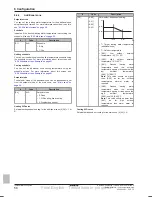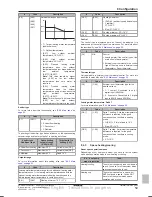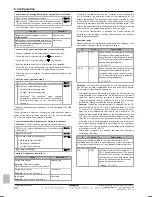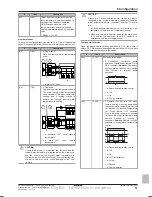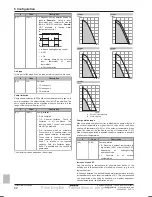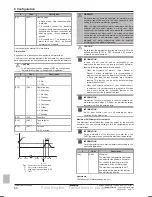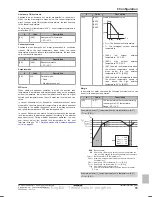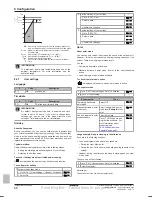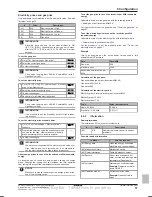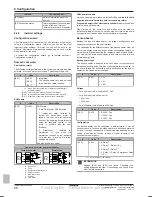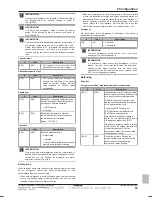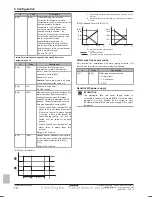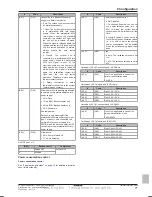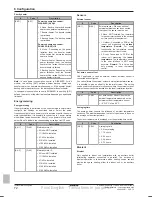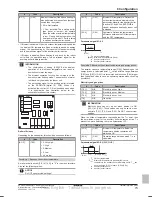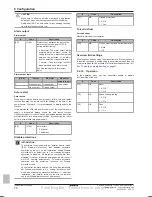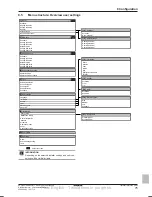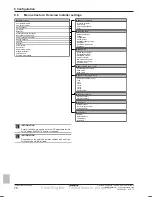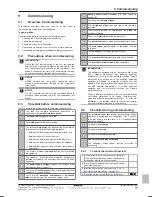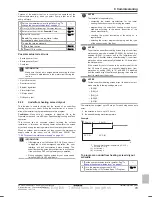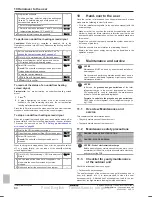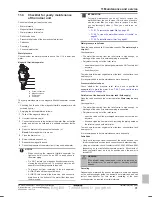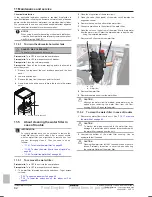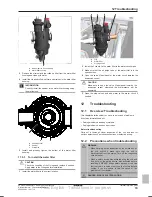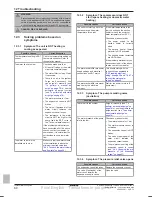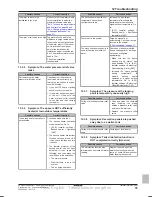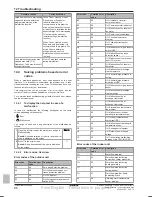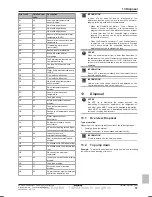
8 Configuration
Installer reference guide
72
ERGA04~08DAV3(A) + EHVH/X04+08S18+23DA
Daikin Altherma – Low temperature split
4P495248-1 – 2017.12
Priority heater
#
Code
Description
[9.9.D]
[4-01]
Power consumption control
DISABLED [4‑08]=0
▪ 0 None : Backup heater and booster
heater can operate simultaneously.
▪ 1 Booster heater: The booster heater
is prioritized.
▪ 2 Backup heater: The backup heater
is prioritized.
Power consumption control
ENABLED [4‑08]=1/2
▪ 0 None : Depending on the power
limitation level, the booster heater
will be limited first, before the backup
heater is limited.
▪ 1 Booster heater: Depending on the
power limitation level, the backup
heater will be limited first, before the
booster heater is limited.
▪ 2 Backup heater: Depending on the
power limitation level, the booster
heater will be limited first, before the
backup heater is limited.
Note:
In case power consumption control is DISABLED (for all
models) the setting [4‑01] defines whether backup heater and
booster heater can operate simultaneously, or if the booster heater/
backup heater has priority over the backup heater/booster heater.
In case power consumption control is ENABLED, the setting [4‑01]
defines the priority of the electrical heaters depending on applicable
limitation.
Energy metering
Energy metering
If energy metering is performed by the use of external power meters,
configure the settings as described below. Select the pulse
frequency output of each power meter in accordance with the power
meter specifications. It is possible to connect up to 2 power meters
with different pulse frequencies. If only 1 or no power meter is used,
select 'None' to indicate the corresponding pulse input is NOT used.
#
Code
Description
[9.A.1]
[D‑08]
Electricity meter 1:
▪ 0 None: NOT installed
▪ 1 1/10kWh: Installed
▪ 2 1/kWh: Installed
▪ 3 10/kWh : Installed
▪ 4 100/kWh: Installed
▪ 5 1000/kWh: Installed
[9.A.2]
[D‑09]
Electricity meter 2:
▪ 0 None: NOT installed
▪ 1 1/10kWh: Installed
▪ 2 1/kWh: Installed
▪ 3 10/kWh : Installed
▪ 4 100/kWh: Installed
▪ 5 1000/kWh: Installed
Sensors
External sensor
#
Code
Description
[9.B.1]
[C–08]
External sensor : When an optional
external ambient sensor is connected,
the type of the sensor must be set.
▪ 0 None : NOT installed. The thermistor
in the user interface and in the outdoor
unit are used for measurement.
▪ 1 Outdoor: Connected to PCB of the
indoor unit measuring the
outdoor
temperature
.
Remark:
For some
functionality, the temperature sensor
in the outdoor unit is still used.
▪ 2 Room: Connected to PCB of the
indoor unit measuring the
indoor
temperature
. The temperature sensor
in the user interface is NOT used
anymore.
Remark:
This value has
only meaning in room thermostat
control.
Ext. amb. sensor offset
ONLY applicable in case an external outdoor ambient sensor is
connected and configured.
You can calibrate the external outdoor ambient temperature sensor.
It is possible to give an offset to the thermistor value. This setting
can be used to compensate for situations where the external outdoor
ambient sensor cannot be installed on the ideal installation location.
#
Code
Description
[9.B.2]
[2-0B]
Ext. amb. sensor offset: Offset on the
ambient temperature measured on the
external outdoor temperature sensor.
▪ –5°C~5°C, step 0.5°C
Averaging time
The average timer corrects the influence of ambient temperature
variations. The weather-dependent set point calculation is done on
the average outdoor temperature.
The outdoor temperature is averaged over the selected time period.
#
Code
Description
[9.B.3]
[1-0A]
Averaging time:
▪ 0: No averaging
▪ 1: 12 hours
▪ 2: 24 hours
▪ 3: 48 hours
▪ 4: 72 hours
Bivalent
Bivalent
Only applies to indoor unit installations with an auxiliary boiler
(alternating operation, connected in parallel). The purpose of
bivalent operation is to determine which heating source can/will
provide the space heating, either the indoor unit or an auxiliary
boiler.
Final English - Tanslations in progress

